A symbol of Vietnamese culture and a practical accessory for daily life, the conical hat, or “nón lá,” is an iconic part of Vietnam’s identity. Just a short journey from Hanoi, you can explore the heart of this tradition at Chuong Conical Hat Village, where the art of hat making has been passed down through generations.
What is Chuong Conical Hat Village?
The conical hat in Vietnamese culture
The nón lá is more than just a hat; it’s a symbol of Vietnamese resilience, resourcefulness, and connection to nature. Made from simple materials like palm leaves and bamboo, these hats protect wearers from the sun and rain while also representing the country’s agricultural heritage. The nón lá is often depicted in art, worn in traditional dances, and remains a common sight in everyday life.
Introduction of Chuong Village
Chuong Village boasts a centuries-old tradition of crafting conical hats. These hats, crafted from palm leaves and bamboo, are lightweight and practical, symbolizing Vietnamese rural life and culture. The village is nestled along the Day River, which provides the essential palm leaves used in hat making.
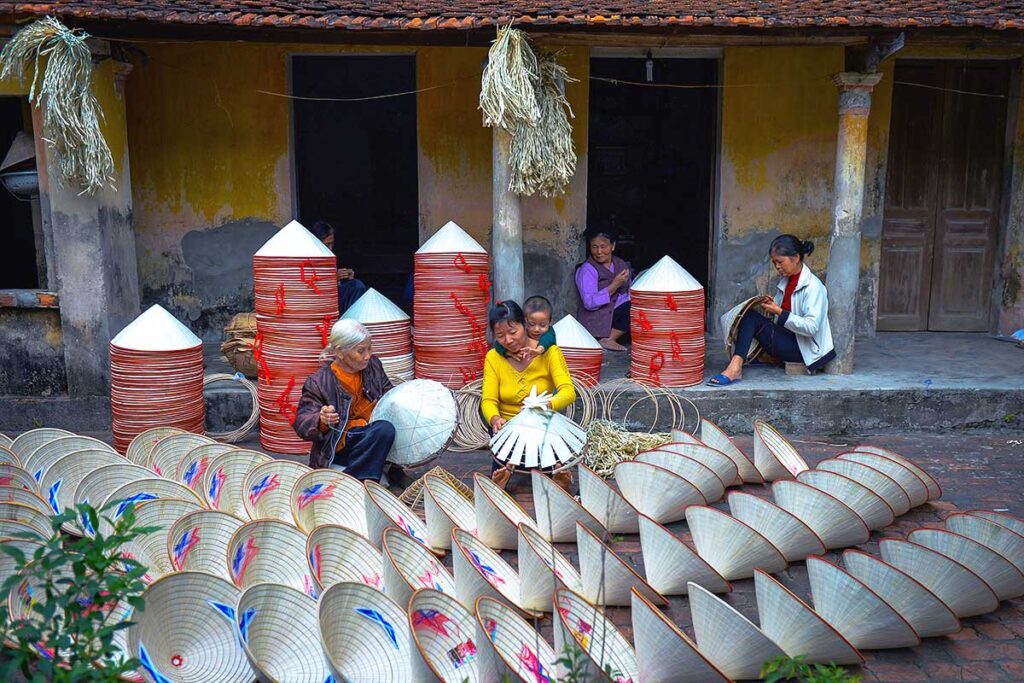
While hat making isn’t the villagers’ primary occupation, it supplements their income from agriculture and has become a source of pride for the community. The craft has been passed down through generations, with each family contributing to the village’s reputation for producing high-quality nón lá.
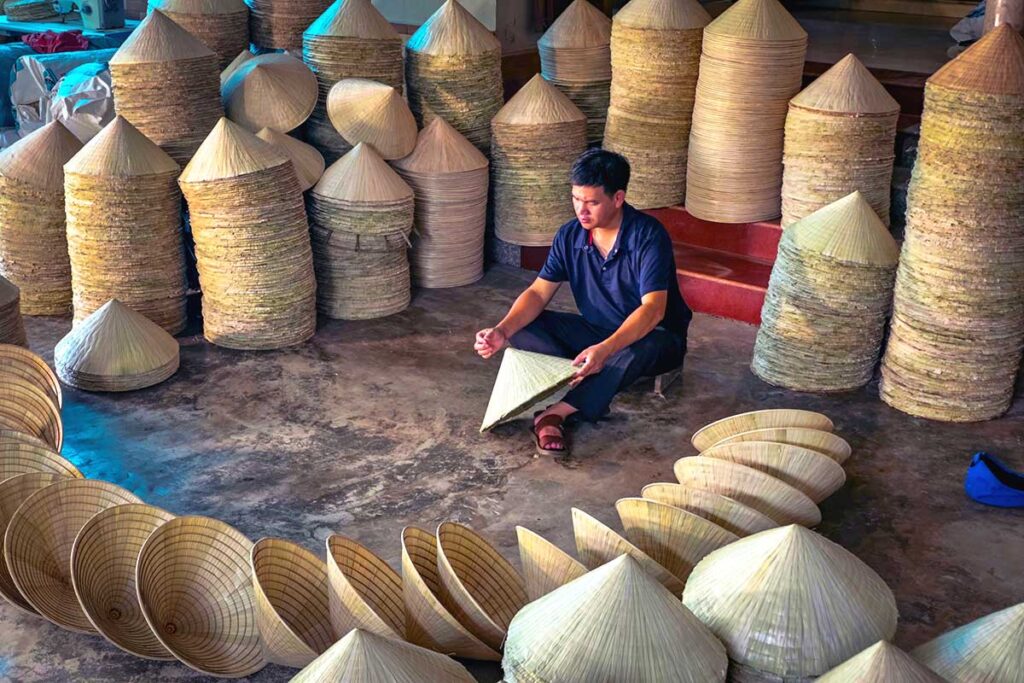
History of Chuong Village
With a history spanning over 300 years, Chuong Village has long been a center for conical hat production. The village’s expertise in crafting high-quality hats has made its products highly sought after throughout Vietnam. Over generations, this craft has been passed down, ensuring that the skills and traditions remain intact.
The craft of conical hat making
Chuong Village is renowned for its meticulous craftsmanship in making conical hats. The process involves selecting the best palm leaves, bamboo, and other natural materials. Artisans then skillfully weave these materials into the distinctive conical shape, ensuring durability and elegance. Each hat is a product of hours of labor and skill, showcasing the artisan’s expertise and dedication.
How to Make a Conical Hat?
Creating a conical hat in Chuong Village is a detailed and fascinating process that involves several key steps:
- Selecting Materials: The process begins with choosing high-quality palm leaves and bamboo. These materials are essential for making durable and attractive hats.
- Preparing the Leaves: The selected palm leaves are dried under the sun, then soaked in water to increase flexibility. Afterward, they are ironed flat to smooth out any wrinkles.
- Creating the Frame: Bamboo is cut into thin strips and shaped into a circular frame. This frame forms the base of the conical hat.
- Weaving the Hat: The palm leaves are carefully sewn onto the bamboo frame, layer by layer. This step requires precision to ensure the hat’s shape and stability.
- Finishing Touches: Once the hat is fully assembled, additional decorations like embroidery or painting may be added. These details give each hat a unique and personalized look.
- Drying: The final product is dried in the sun to ensure all materials are set and the hat maintains its shape.
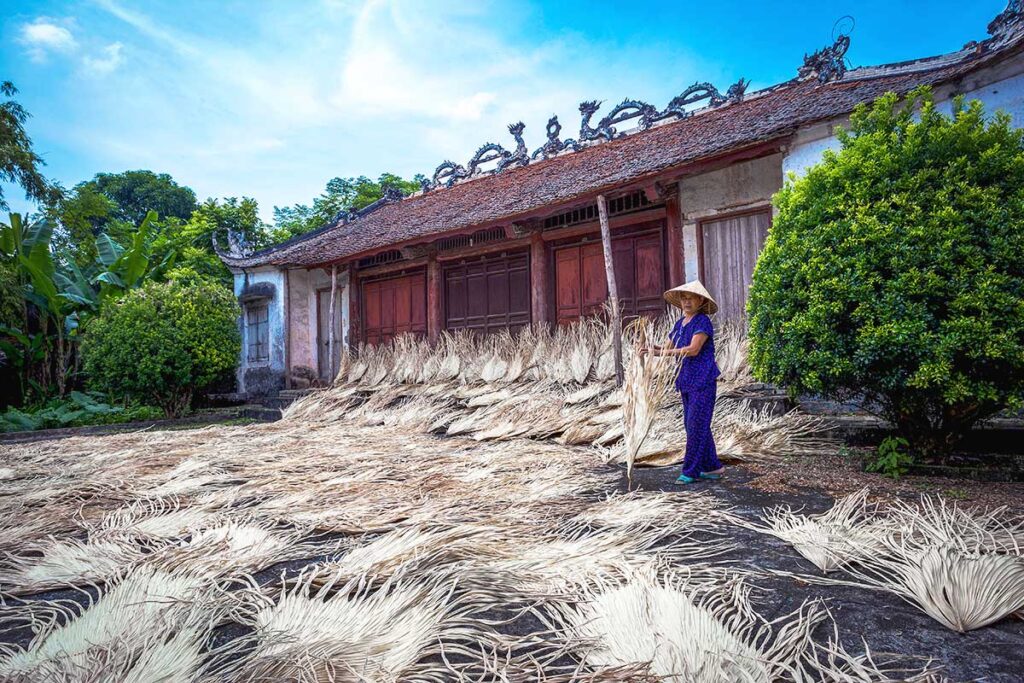
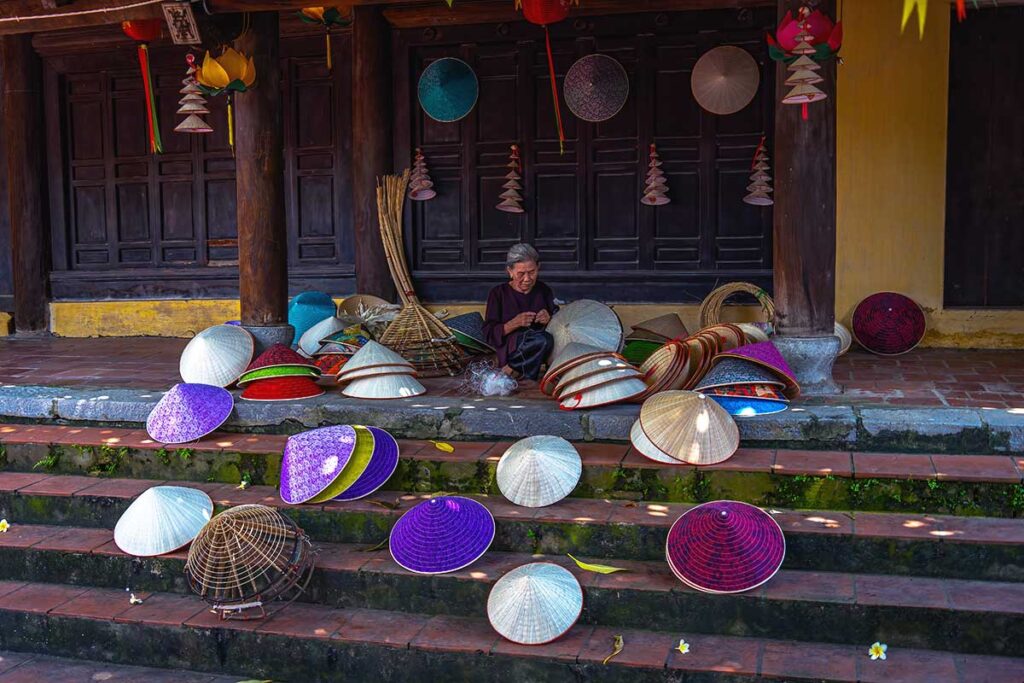
Highlights of Chuong Conical Hat Village
1. See traditional hat making
One of the main attractions is watching the artisans at work. Observing the entire process, from preparing materials to the final touches, provides a deep appreciation for the craftsmanship involved in making each conical hat.
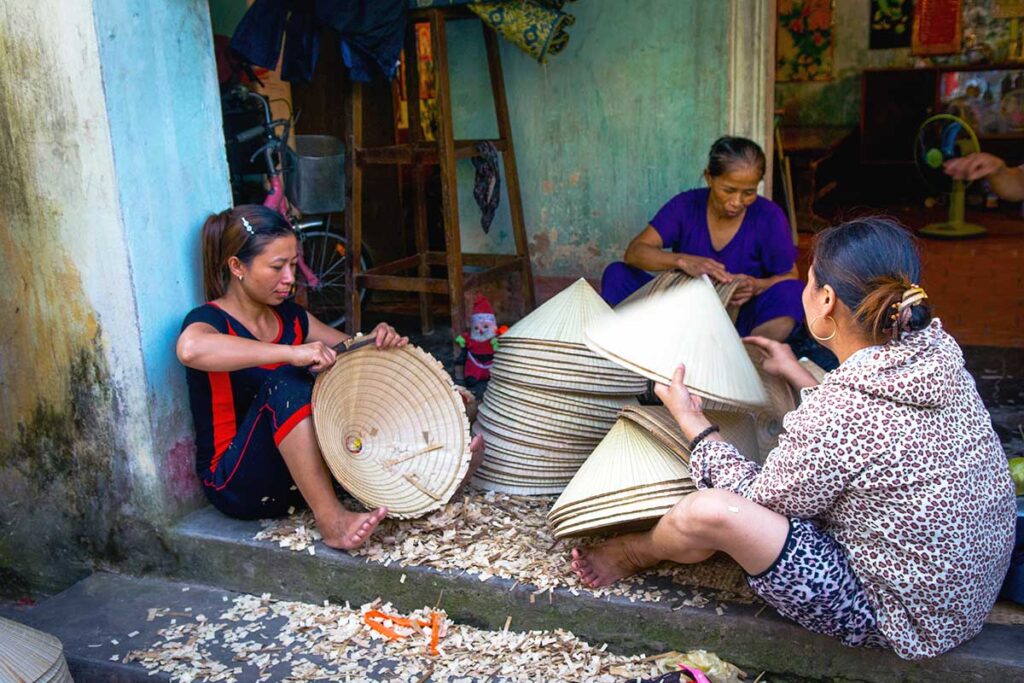
2. Participate in Workshops
Join a workshop to create your own conical hat. Guided by local artisans, you can learn the basics of hat-making and take home a personalized souvenir. This hands-on activity is both educational and enjoyable.
3. Explore the village market
The village market, held on the 4th, 10th, 14th, 20th, 24th, and 30th of every lunar month, is a bustling event where you can buy handmade conical hats. The market, located in the garden of Chuong Pagoda, operates for only two hours in the early morning. The sight of white conical hats everywhere creates a unique and lively atmosphere. Hats range in price from 30,000 to 150,000 VND, depending on their complexity and decorations.
4. Visit the Chuong Village Festival
Every year on the 10th of the third lunar month, Chuong Village hosts a special festival. This event features traditional games like wrestling, human chess, and rice cooking competitions. The festival attracts both locals and tourists, offering a vibrant celebration of the village’s culture and heritage.
5. Discover the Chuong Village Communal House

The Chuong Village Communal House, also known as Lang Chuong Temple, built in 1894 during the reign of King Thanh Thai, is a beautiful example of Nguyen Dynasty architecture. Located near the national highway, it features intricate carvings of dragons and sacred creatures, along with many preserved historical artifacts. The communal house is a cultural treasure that provides insight into the village’s history and traditions.
How to Get there from Hanoi
Chuong Conical Hat Village is approximately 30 kilometers (about 19 miles) from Hanoi, which translates to roughly an hour of travel time by car, depending on traffic. Here are the best options to get there:
Private car with driver
The most convenient way to visit Chuong Village is by hiring a private car with a driver from Hanoi. This option is preferable to taking a taxi for longer distances, as a private car provides more comfort and flexibility. Your driver will wait for you while you explore the village and can also take you to other nearby attractions before bringing you back to Hanoi.
Going by tour
While there are no group tours available, you can book a private tour to Chuong Village. This option is similar to hiring a private car but comes with the added benefit of an English-speaking guide. Private tours often include entrance fees and sometimes meals, providing a more comprehensive and informative experience.
If you’re interested in visiting Chuong Conical Hat Village, we at Local Vietnam can arrange both private tours and drivers. Just contact us with your preferences, and we’ll handle the rest.
Combing with Quang Phu Cau Incense Village
Not far from Chuong Conical Hat Village, Quang Phu Cau Incense Village is only 8 kilometers away, less than a 20-minute drive. This village is a favorite among photographers and Instagrammers, known for its vibrant incense-making process. The sight of colorful incense sticks drying in the sun creates a picturesque and unique backdrop. Visiting Quang Phu Cau in addition to Chuong Village can enrich your travel experience.
Is it worth visiting Chuong Conical Hat Village?
While Chuong Conical Hat Village offers a fascinating glimpse into traditional Vietnamese craftsmanship, visiting it alone might not justify the travel time from Hanoi. However, combining your trip with nearby attractions like Quang Phu Cau Incense Village makes the journey more rewarding. If you’re willing to make it a full-day excursion, you can even extend your trip to the Perfume Pagoda, located further south of Hanoi. This way, you can experience a variety of cultural and historical sites in one day, making the most of your travel time.
Other craft villages around Hanoi
Experience the variety of Hanoi’s craft villages. Quang Phu Cau Incense Village is famous for incense, Bat Trang Ceramic Village for pottery, and Van Phuc Silk Village for its luxurious silk. Duong Lam Ancient Village, Le Mat Snake Village, Chang Son Hand Fan Village, and Quat Dong Embroidery Village provide even more cultural insights and unique crafts.






